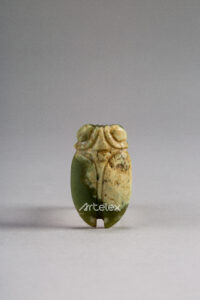This jade sculpture represents a cicada, with the jade’s color ranging from green to patches of white. The two eyes are prominently protruding, and the neck is adorned with broad, binding lines. The wings slope downward, and the body is thickest in the middle, gradually tapering towards both ends. The underside of the sculpture is flat.
In Hongshan culture, cicada sculptures in the form of larvae are more common than those depicting adult cicadas. While it remains uncertain whether the custom of making jade plugs existed in Hongshan culture, the practice of placing objects in the mouths of the dead dates back to the Stone Age. Jade cicadas were used as a type of jade plug, a tradition preserved from the Shang and Zhou Dynasties. The custom of crafting jade plugs in the shape of cicadas is thought to have originated in the Western Zhou Dynasty and became prevalent during the Qin, Han, and Southern and Northern Dynasties.
The cicada symbolized rebirth and immortality, and it was also revered as a divine insect. People placed jade cicadas in the mouths of the deceased, hoping for their resurrection, akin to the cicada’s life cycle.

